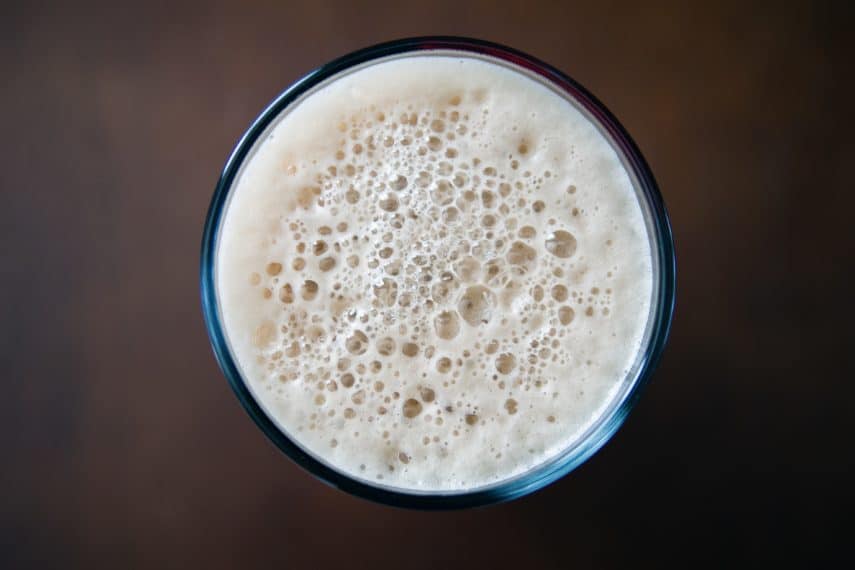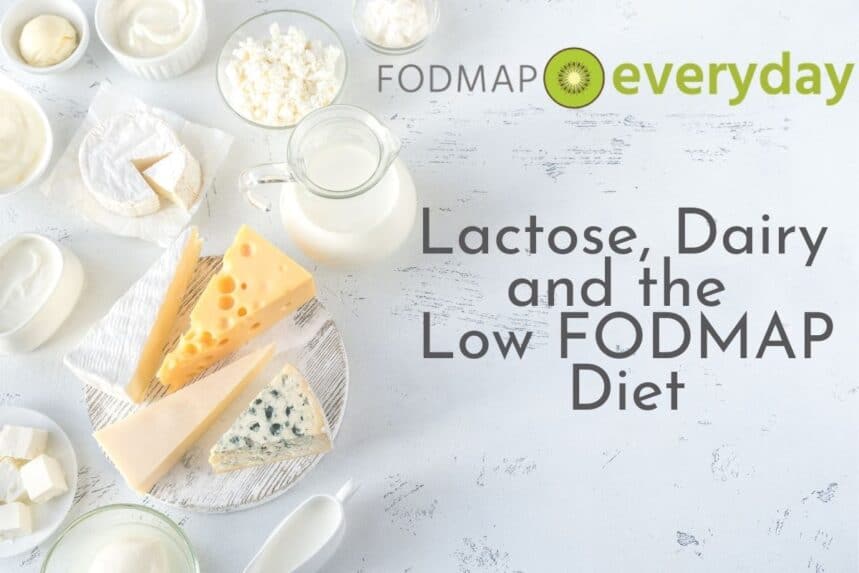Lactose, Dairy & the Low FODMAP Diet
When I attended the Food and Nutrition Conference and Expo (FNCE) this past October, I was surprised to see lactose-free butter at one of the exhibitor booths. Why was I surprised? Because even though butter is made from milk, it is primarily composed of fat and naturally very low in lactose.
So I asked one of the company’s reps about it, and their response was: “It’s what customers want.” Let’s sort out some of the confusion surrounding lactose and dairy products.
Lactose, Dairy & FODMAPs
Even if you’ve only recently heard of FODMAPs, you’ve probably known about lactose for a long time. Lactose, represented by the “D” in FODMAP, is a disaccharide (sugar) that is naturally present in milk and foods made from milk, and it requires the enzyme lactase for digestion.
You May Want To Read: What Are Disaccharides?
Lactose intolerance is common – about 65 percent of the global population has a decreased ability to digest lactose after infancy[1]. The amount of lactose, however, that a person can tolerate and the symptoms they experience upon ingestion can vary significantly between individuals. Additionally, lactose content varies with the type and portion size of a dairy food.
Lactose-Free Doesn’t = Dairy Free!
As a dietitian, I’ve worked with many patients who are lactose intolerant and assume they need to avoid dairy. Individuals on the low FODMAP diet often have the same misconception. If you have lactose intolerance and/or IBS and are following the low FODMAP diet, you need to limit lactose, but you can still consume dairy.
According to a review of the research on lactose intolerance, most individuals with lactose intolerance can tolerate 12 to 15 g of lactose, the equivalent of one cup (240 ml) of milk[2]. Another small study showed that some lactose-intolerant individuals may be able to tolerate up to two cups of milk (480 ml) a day if it is spread out over the day and consumed with other food at a meal.[3]
You Can Have Cheese!
Believe it or not, there are many conventional cheeses that are low FODMAP: cheddar, mozzarella, Parmesan, Swiss, Monterey jack and so many more. Check out our article, Is Cheese Low FODMAP? to learn how to tell if any cheese – or really, any dairy product – is low FODMAP. It’s all about reading the nutritional panel. If the sugars are 1g or less per serving, the product is lower enough in lactose to be low FODMAP.
Lactose-Free Options & Non-Dairy Substitutes
If you are following the low FODMAP diet and need to limit lactose, you have options! Lactaid is a brand of lactose-free milk and cottage cheese, and Green Valley Organics has a wide range of lactose-free dairy products, including yogurt, sour cream, kefir, and cream cheese.
Lifeway is another brand of kefir, and although they do not add lactase enzyme to their products, they state their kefir is up to 99% lactose-free and safe for most people with lactose intolerance. According to the company’s website, they use 12 specific kefir cultures that break down the lactose in the milk during a long fermentation process (14-18 hours)[4].
This is similar to how some sourdough breads are lower in FODMAPs because the fermentation process breaks down the fructans. Although kefir has been given a red light on the Monash University Low FODMAP Diet Smartphone App due to high levels of lactose, Lifeway plain kefir is a product I may suggest for someone to try who is limiting lactose.
Non-Dairy Alternatives
Nowadays, there are also plenty of non-dairy milk and dairy substitutes available. You can find milk, yogurt, cheese, and kefir made from plants such as soy, almonds, hemp, oats, and macadamia nuts.
Keep in mind, however, that although non-dairy milk and dairy substitutes are lactose-free and dairy-free, they are not always low FODMAP. The same is true for flavored lactose-free dairy products – choose the plain option or check the ingredients list for high FODMAP ingredients like apple, banana, or pear.

Simple Swaps
Here are some simple swaps to go lactose-free:
-
- Pour lactose-free cow’s milk or almond milk on your breakfast cereal.
- Try lactose-free yogurt or goat milk yogurt with low FODMAP granola.
- Make smoothies with lactose-free kefir or almond milk kefir.
- Top tacos with shredded cheddar or crumbled feta cheese.
- Use canned coconut milk in creamy soups and curries.
Lactase Enzyme Caplets
Lactase enzyme caplets are another option that may help people with lactose intolerance, although they may not be as effective as lactose-free foods. I recommend not using lactase enzymes during the elimination phase, and only use them after you have determined you are sensitive to lactose in the reintroduction phase.
Also, if you are sensitive to polyols, look for a lactase enzyme that does not contain mannitol, such as Lactaid Fast Acting Caplets. (Note that there are two different kinds of Lactaid tablets and only one kind is mannitol-free).
And Remember!
If you are avoiding dairy for any reason – including lactose intolerance, IBS, dairy allergy, or dietary preference – talk to a Registered Dietitian to make sure that your diet is meeting your needs and helping you feel your best.
Make Your Own Lactose-Free Ingredients
We have several recipes for basics that you may think you cannot eat anymore if you are lactose intolerant – but you can now! And they are low FODMAP! For all of our lactose-free recipes just go to our RECIPE page and check the “lactose-free” box in our filter!
- Lactose-free Ricotta
- Lactose-free Buttermilk
- Lactose-free Egg Nog
- Lactose-free Cheesecake Pie
- Lactose-free Sour Cream Horseradish Sauce
- and more lactose-free recipes here…..
AND We Have A DIY Option
Check out our article, DIY Lactose-Free Dairy to learn how to CREATE your own lactose-free milk, cream, half-and-half and more.
**Note on Food Intolerances and Food Allergies
A food intolerance is not the same thing as a food allergy, although both can cause gastrointestinal symptoms.
-
- Food intolerances often manifest as excessive gas, indigestion, diarrhea, and bloating, and are typically caused by digestive enzyme deficiencies (such as lactase deficiency in lactose intolerance) or sensitivity to various food components (such as food additives and gluten).
- A food allergy occurs when your body’s immune system reacts to a component in food — typically a protein — causing symptoms that can range from mild (itchy mouth, indigestion) to severe and potentially life-threatening (anaphylaxis).
Individuals with a milk allergy must avoid all milk and dairy, regardless of lactose content. If you have a food allergy, it is imperative that you check labels since milk and dairy products are used in a variety of packaged foods, including breakfast items, soups, and baked goods.
READ MORE ABOUT ALLERGIES VS INTOLERANCES HERE.
For some low FODMAP recipes featuring lactose-free dairy, check out our:
- Chicken & Spinach Lasagna
- Beef Stroganoff
- Parmesan Crusted Flounder
- Grits
- Sour Cream Blueberry Bundt Cake
- Banana Cream Pie…and so many more.
References
[1] National Institute of Health: US National Library of Medicine. Lactose Intolerance. 2017. Accessed on 8 Dec 2017. <https://ghr.nlm.nih.gov/condition/lactose-intolerance#statistics>
[2] Shaukat, A et al. Systematic review: effective management strategies for lactose intolerance. Annals of Internal Medicine (2010). Accessed on 10 Dec 2017. <https://www.ncbi.nlm.nih.gov/pubmed/20404262>
[3] Suarez, FL, et al.Tolerance to the daily ingestion of two cups of milk by individuals claiming lactose intolerance. American Journal of Clinical Nutrition (1997). Accessed on 8 Dec 2017 <https://www.ncbi.nlm.nih.gov/pubmed/9129483>
[4] Why Our Kefir is Up to 99% Lactose Free. 2015. Published 10 Aug 2015. Accessed 10 Dec 2017. https://lifewaykefir.com/why-our-kefir-is-up-to-99-percent-lactose-free/









Hi! In options and ideas for swaps, you mention goat’s milk cheese. I’ve heard this is easier on some people’s stomachs but wasn’t sure about the FODMAP content. Has this been studied? Thanks!
Hi Kelsey, yes goat cheese is low FODMAP! Monash has tested goat cheese (plain chevre) and given it a green light rating for 1/4 cup (30g) and 1/2 cup (60g) servings.
Awesome! I think in my original comment, I said cheese when I meant to say yogurt (guess I wanted some…) I knew I could eat goat cheese, I just was still steering clear of it in yogurt form since most other yogurts are higher in lactose. Thank you!
Hi Kelsey, As Rachelle referenced, Monash University provides the information within their smartphone app. We highly suggest that you get this app, which all of us refer to all the time. It is the most convenient way to have up-to-date ingredient information at your fingertips. If you prefer a print version, Monash has a booklet, as well. You can find both here.
Thank you so much for the info! I have had the app for a while now and use it all the time, I had just missed the goat’s milk yogurt item being green! Yay for more yogurt options! 🙂 thanks for sharing!